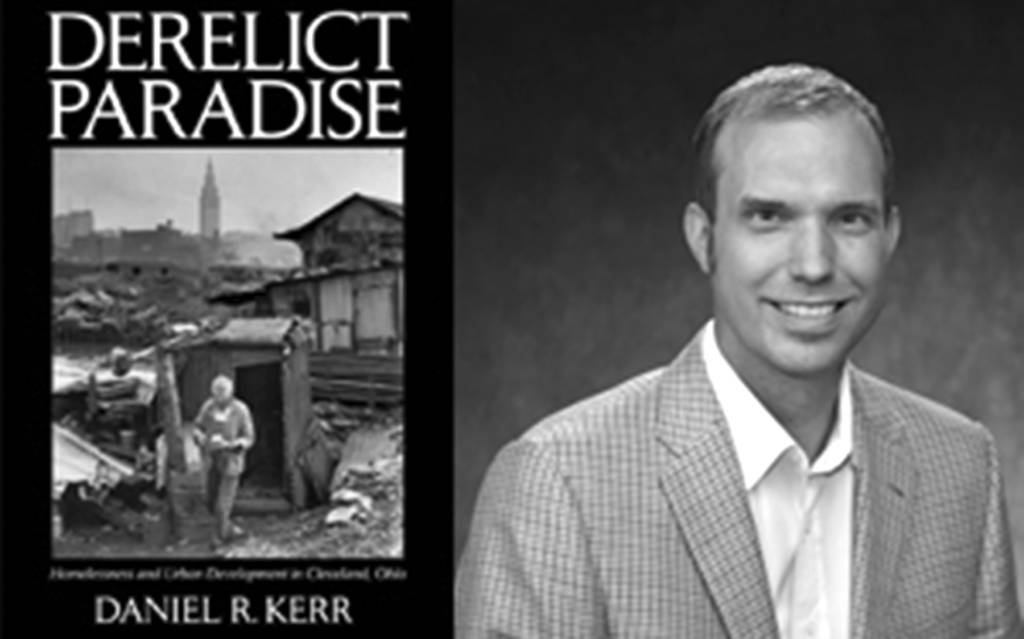What started as an oral history of people experiencing homelessness has become an in-depth historical view into the forces that have contributed to the persistence of homelessness in the United States.
In his book “Derelict Paradise,” published by the University of Massachusetts Press in 2011, Daniel Kerr seeks to understand why homelessness has apparently become more entrenched than ever in our society, despite the billions of dollars spent on shelters and social services to end it.
Kerr, now an assistant professor at American University, was raised in Cleveland at a time when homelessness was often a feature story on the evening news. But rather than dedicate himself to the academic study of solving homelessness, he decided he wanted to participate first-hand in the solutions of the day. He joined the squatter’s movement in New York City, where participants claimed abandoned factories and warehouses as places to live.
Kerr came away from several years of participation in the movement with a growing sense of a paradox: that many organizations and policy makers were championing programs and initiatives that often served to institutionalize homelessness rather than to end it.
Desiring a real discussion of the causes and solutions to homelessness, Kerr began his oral history project with his fellow squatters before returning to his hometown.
“Derelict Paradise” was written as an exploration of more than a century of homeless policies and practices in Cleveland. The title was drawn from a report to the Cleveland City Council by service providers frustrated that organizations often competed to provide relief services to people experiencing homelessness. These service providers claimed the widespread availability of help from various sources made Cleveland into a paradise for vagrants and derelicts.
Using stories from local newspapers, official documents, and interviews, Kerr takes readers on a journey into homelessness from the peak of the Industrial Revolution through the Great Depression, postwar urban renewal, to the growing racial tensions of the 1960s to the resurgence of homelessness at the end of the 20th century.
From the days of the Industrial Revolution, where skilled workers were of¬ten displaced by lower skilled and lower cost workers, Kerr looks at successive waves of loss and disenfranchisement. Even as the workforce became increasingly expendable and living costs rose, policy makers failed to give much thought to how workers should go about recovering that which they were losing. The theme is carried throughout the book as low-income residents are forced from their homes to make way for higher rent addresses and amenities for the rich. Shelters and jails have contained the displaced poor, but have not replaced that which was taken away.
While the theme of lost space and opportunity carries through the book, “Derelict Paradise” seeks to look beyond the effects to the causes. Kerr contends that the organizations and public officials and community leaders entrusted with the task of eliminating homelessness also frequently benefit from the implementation and continuation of policies that, in practice, perpetuate it.
“Derelict Paradise” was written with deep insights into the experience of homelessness, yet also lays out the plans, programs, policies and practices designed by decision makers. And while Kerr’s sympathies seem to lie with the poor rather than the persons making the decisions, he is careful to point out, the primary actors believed they were making the right decisions for the good of the community and usually did not intend to perpetuate social injustice.
The author worked hard to make his book engaging and readable in hopes that someone living in a shelter or on the street might pick it up and see their own story in the larger narrative. Yet readers should not mistake the accessibility of the book for easy reading. Many of the topics Kerr tackles have been the focus of entire volumes twice as long as “Derelict Paradise.”
In the end, Kerr’s book offers a vitally important historical perspective on policies and practices affecting homelessness. By focusing on one city, rather than tackling the entire spectrum, Professor Kerr is able to draw direct lines from specific policies and measurable effects.
For anyone wanting to learn about the causes and history of homelessness in the United States, “Derelict Paradise” is indispensable.








